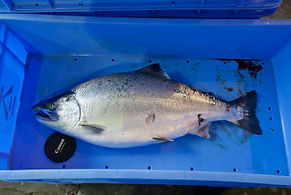
~モデルプラン~ 蒼海の白銀に酔いしれる春の釣り旅。 北海道のサクラマス
ガイド時期:4月中旬〜6月中旬
催行日数:1日から受付できます
※サクラマスを対象とする場合、ニセコ/積丹に限ってガイドを承ります。
ガイド料金の平均的な目安:
¥70,000 ~ ¥200,000
※料金はプライベートガイドで実際にこちらのプランを申し込む場合の目安で日数によって異なります。
上記は過去の利用者の実態から一般的な目安となる平均的な金額と考えて参考にしてください。
◆このプランはプライベートガイドの申し込みフォームからお申し込みができます。 フォームにてプラン名をご選択ください。
◆実際には天候や海の状況次第で釣りの内容を変更しなくてはならないことがあります。了承の上お申込みください。
◆お支払いが済んでいないお客様への「 質問・問い合わせ 」へのガイドの対応は固くお断りします。
◆こちらの開催地は”ニセコ/積丹” での開催となります。他地域での催行はできません。
◆このガイドプランの催行時期は4月中旬〜6月中旬となります。それ以外の時期の催行はしません。
◆1日からのお申し込みが可能です。 また、これらの当ガイドが指定する以外の地域での受付はしません。
◆このガイドプランの平均的なガイド料金総額は¥70,000~¥200,000です。*2024年度の催行実績に基づいて算出。
◆基本的に2〜3名を参加上限人数とさせていただきます。
◆こちらのプランではルアーフィッシングもしくはフライフィッシングに対応します。それ以外の釣りの方法には対応しません。
◆”ニセコ/積丹” 地域限定です。主にボートを使用します。 (天候によって内容は変更となる場合があります)
◆こちらのプランにはお客様の宿泊・食事・交通費は含まれていません。
◆日本では法的な規制によりフィッシングガイドをタクシーの代替手段としてお客様が利用することはできません。
◆送迎は承っておりません。 現地への移動にはレンタカーをご利用ください。
◆こちらのガイド中に食品類の提供はありません。
◆ガイドは調理を行いません。
◆用品類のフルレンタル・オプションがご利用いただけます。
◆雨天決行です。 天候条件が良くない場合ガイドが代替のプランに切り替えることがあります。
◆当日の集合場所・時間につきましてはガイドと相談してください。
◆こちらのガイドメニューは現地ガイドが特に推奨する”プライベートガイド”のモデルプランとなります。 料金はプライベートガイドの地域/日数の料金となります。
◆詳細はプライベートガイド詳細案内をご覧ください。
4月中旬〜6月中旬のガイドパターン



ニセコ/積丹エリア。 3月中旬くらいから北海道のサクラマスの釣りがスタートする。 サクラマスの釣りは原則的に船。。 許可を受けたボートに乗船することによってライセンスを持っていると判断される仕組みだ。 ちなみに北海道では岸からのルアーキャスティングで行うサクラマスの釣りが何かと安易に雑誌やネット上では話題になっているが… 実際のところはどうかというと、、 岸からのキャスティングはあまりにも釣れる確率が低すぎるため、地元の人間でもやる人は限られている感じ。確実に近い確率で釣る人も確かにいるにはいるが、そういう人はとんでもない経験の持ち主で長年の努力を欠かさなかったからこそできるのであって、同じことが誰にでもすぐにできるものではない。 実際の岸釣りの釣れ方の肌感覚はといえば… 1週間続けて毎朝釣り場にせっせと通い、その中で運が良ければ1匹釣れるかどうか‥ といったところ。 釣れる釣れると情報を煽っている犯人はというと… 日本の釣具メーカーである。 釣具メーカーとしてはルアーや用品が売れさえすれば良いわけだから、毎年このサクラマスの岸釣りに関しては実際の釣果以上に騒ぎたてて、用品の需要を喚起しようと躍起になっているというわけ。。 そういうウラがあるので、、 巷での岸から釣れた! などという安易なネットや釣り新聞、SNSなどの軽薄な情報を真に受けて「 自分にもタダでサクラマスがすぐに…それも… 必ず釣れる! 」 などと… 痛い勘違いをしてしまわないこと。 実際のところ時期になってSNSで幸運にも釣れた人が騒ぐと… 大挙して地元アングラーが海岸に押し寄せるが… 彼らのうちのほぼ大半の人間がノーヒットでその場を後にしている。 その辺はもうインターネット時代あるあるなので、、最近では以前ほど大仰に騒がれなくはなってきている。 北海道の慣れた地元アングラーでもサクラマスの岸釣りは「 くじ 」に当たるような釣りである。 そんなに世の中は甘くない。 遠路を訪れるタイミングとチャンスの限られた釣りには迷わず船を選ぼう。
おおむね天候が安定してくるのは4月中旬くらいから。 それまでの3月からの早い期間はなんだかんだと天気が荒れる日が多く、周期的に荒天を繰り返すことが多いため、遠路を釣りのためだけに訪れるビジターにとっては難しい時期である。 3月初旬くらいからサクラマスはまず沖のバーチカルジギングで釣られ始め、バーチカルジギング中心の釣り期が長い年では4月中旬くらいまでは続く。 天候が安定し始める4月中旬くらいからは沖のバーチカルジギングがまだ続いていることもあるし、トドやイルカなどの海獣類の増加によっては沖ではサッパリ釣れずに終了していることもある。 この辺は地元の経験豊富な船頭たちですら予測が難しい。 沖で釣れなくなったサクラマスはどうしているかというと、今度は岸に寄ってくる。 そうなると今度はバーチカルジギングではなくキャスティングで表層付近を狙う釣りが成立するようになってくるのである。 4月中旬くらいからは船からのキャスティングで狙ってゆくスタイルが中心となる。 いずれにしても天候、魚の数、確率などが安定してくるのは4月の中旬を過ぎてからということになるだろうか。 4月中旬から5月末くらいまでがサクラマスは釣れやすい良い時期といえる。


解説:北海道サクラマス・タックル最前線



サクラマス釣りのタックルについて紹介。
3月〜4月:バーチカルジギングの場合
この時期には、一般的なオフショア用のライトジギングロッドで十分対応可能である。ロッドの長さは6〜7フィート、硬さはML程度が適している。リールはベイトリールでもスピニングリールでも構わないが、バーチカルジギングで重要なのは、水面からフックまでの正確な距離を把握できるようにしておくこと。
この点をサポートするため、以下の道具がおすすめとなっている:
-
ラインカウンター機能付きベイトリール
-
スピニングならメーターごとに色分けされたPEライン
ただし、実際の釣りではアナログ感覚が中心になるため、あまり神経質になる必要はない。メインラインはPEライン、リーダーはナイロン製を使用する。リーダーの長さは5メートル程度にしておけば、不慣れな場合に多発してガイドや船頭からこっぴどく怒られる水際での危険なすっぽ抜けを防止しやすくなる。
また、ジグは大小さまざまなものが実績を上げており、釣り場の状況に応じて使い分ける。より効率よく釣りたい場合は、積丹半島特有の「シャクリ仕掛け」を活用すると良いだろう。
初心者がこれらをすべて自分で準備し、最初から完璧に揃えるのは難しいことが多いため、ガイドを雇う際には全て任せるのが、時間的にも費用的にも最善の選択である。
4月中旬以降:船からのキャスティングの場合
この時期には、一般的なシーバスロッドがちょうど良い選択となる。ロッドの長さは8〜9フィート、硬さはML程度が適している。リールはスピニングリールが最適で、わざわざベイトリールを選ぶ必要はない。 ベイトリールを選んで良いことがこの釣りでは何一つないからである。 「 ベイトがかっこいいから 」 という理由で使うのは個人の勝手だが‥ 実際のところそうしたことを「 カッコいい 」などと思ってみてくれている人間など、いまの時代ではもう皆無であることは付け加えておく。 「自己満足」というわけだ。 同様のことはルアーについても言える。ミノーである。 日本の釣具メーカーというのはミノーを売るのがイチバン儲かるのだそうである。 釣具メーカーの売上販売に貢献したいのであれば… 高価なミノーを使えば良い。 それで釣れたら無償で彼らの宣伝に協力してあげるのも個人の自由である。 彼らメーカーからの感謝状が届くかどうかは… 知らないが。。
タックルの構成は以下の通り:
-
メインライン:PEライン
-
リーダー:ナイロン製
-
ルアー:ジグ(さまざまなタイプが使用可能)
こちらのキャスティングタックルも、経験が浅いうちは自分で完璧に揃えるのが難しいため、ガイドに準備を任せるのが間違いない方法。フリーレンタルオプションを利用すれば、その日の状況に応じてガイドが適切なタックルを用意してくれるので安心できるのではないだろうか。
タックル準備における注意点
タックルを自分で準備する場合には、それなりの経験が必要となる。初めての人が想像だけで道具を揃えるのも悪くはないが、いざ釣りを始めてみると「ここまでの装備は必要なかった」という無駄な投資が発生することも多い。そのため、最初はレンタルを利用するのがイチバン賢明な選択と言えるだろう。
また、個別のタックル相談についてはガイドも対応しているが、事前に電話やメールでの相談が必要な場合は、別途料金が発生するオプション対応とさせていただいている。
知られざる”北海道的”サクラマス釣りの魅力。。



北海道のサクラマスの釣りは…思いのほか、日本国内でもあまり知られていない。本州では河川内でサクラマスを釣ることが一般的とされていて、あまりの釣れなさ具合から「幻の魚」呼ばわりされるくらいの魚だが、北海道ではサクラマスは海でのみ釣りが許されている。河川内でこれを釣ることは御法度だ。
思うに、釣りの舞台が川ではなく海であることが、日本のアングラーからこの釣りが不遇に敬遠される一番の理由ではないかと目される。釣り人の嗜好というのは、決して漁獲だけを目的にしているわけではない。美しい風景や自然の中で過ごす時間にこそ価値を見出す総合的なレジャーとしての側面があるからだ。
しかしながら、海での漁獲量はさすがの北海道。決して珍しい魚ではなく、最近ではむしろ秋のサケよりもその釣果が安定しているくらいだ。本州であまりにもサクラマスが釣れないことから、北海道まで渡ってきて、このサクラマスを何とか釣ってやろうと試みる本州アングラーは結構いる。
しかしながら!前にも述べたように、北海道では河川内ではサクラマスは問答無用で「禁止された釣りの対象魚」とされており、これを釣るためには春にまだ海にいる間の釣りに季節が限られている。具体的には積丹では早くて3月から。12月~2月にもいないわけではないが、その頃は魚体が小さく、数もまとまっていないため、専門で狙う人は少ない。前の年に海に降りた小さなヤマメがたった一冬を沿岸で過ごしただけでこれほど巨大に成長するのには驚かされる。
ちなみに、この「積丹半島」は日本に生息するサクラマスの最大聖地であることが、長年の水産庁など関係機関の専門的な研究の結果として判明している。詳しいことをここで説明し始めるととんでもない文字数となるから、ここでは結論だけを先に言うにとどめるが、日本国内で最も大きなサクラマスが、最も数多く… 密度高く集まるのがこの「積丹半島」なのだ。
例年、水揚げまたは釣獲される最大クラスでは6キロを超えるものも上がる。そこまでの大物はなかなか珍しいが、4キロを超える魚体はそこそこの確率で釣れる。これは、北海道広しといえども、この積丹半島の春の最大の魅力となっている。
4キロを超えてくるサクラマスはどんなものかというと…この写真のものは4.4キロ。まるでラグビーボールのような体型であり、地元では昔から「板マス」と呼ばれている。そのあまりの体高ぶりから推して考えるに、そのファイトは強烈かつ豪壮なものだ。
しかるに、日本でサクラマス釣りを愛好する人間は少なくないが、少なくともこれだけのクオリティの釣りが、日本国内でもかなり気軽に、ここ積丹半島で季節になると行われているということを、もっと広く知られても良いのではないかと思う。
わざわざ大枚をはたいて第3国経由でロシアの奥地などへ行き、川に入って痩せこけたサクラマス釣りをするよりも、日本国内でこれだけの釣りがカジュアルに行われている事実を知ってほしい。
。
サクラマスは英語圏では”Cherry Salmon" サクラマスのことを「マス」と日本人は呼んで秋のサケよりも下に見ているような節もあるが… これは生物分類学上れっきとした”サーモン”であって、食味も脂がのっていて秋サケなどおよびもつかぬほどに美味である。 今や北半球全体で天然サーモンの減少と不漁が相次いで報告される中… この北海道のサクラマス釣りの価値は、、もしかしたら凝り固まった日本の渓流釣り人たちよりも、むしろ今後海外のアングラーたちから高い注目と評価を得られるものなのではないかと思っている
サクラマス釣行に添えるもう一つの楽しみを。。大型ソイと春のロックフィッシュ

4月中旬以降に天候が安定してくると。。 サクラマスの釣りに加えてもう一つ魅力的な釣りが同時にできるようになる。 ロックフィッシュ。。 ソイの釣りである。 4月中旬から5月の下旬にかけてはこのソイ類が産卵のために浅い海域の根にやってくる。 サクラマスの釣りは一般的に早朝のみが良いタイミングなので、朝イチでサクラマスを釣ってポイントが荒れて魚がいなくなってきたらその後に船を移動して底を狙ったジギングでこの産卵に集まってきている良型のソイの釣りもやってみると良い。 タックルは専用を用意しても良いが多くの人はサクラマスのキャスティング用のロッドをそのままこの釣りにも流用してしまう。ラインはPEラインだしメタルジグもちょうどキャスティングのために40g程度のものを使っているのだからこれがまた非常に塩梅が良いというわけ。 ボートから周囲に軽くジグをキャストして底まで沈め‥ リールを巻いてジグを泳がせたり、ロッドを煽ってジグにアクションを加えたりとさまざまな方法があるが、釣り自体はそんなに難しくなく、初心者でも十分に釣れる。 この時期のソイは産卵参加個体ということもあって普段はなかなかお目にかかれないような大型の個体が比較的簡単に釣れる。 大きなものは写真のもので4キロ近いのも釣れることがあり、 ソイの他にも北海道ならではの50センチ近い大型のホッケなども運が良いと群れにあたってほぼ入れ食いの釣りとなることもある。 いずれもみな食味は折り紙付き。。 うまくいけばサクラマスに加えてデッカいソイにこれまたデッカいホッケ… それも大漁となることも珍しくない。 時期的には4月の中旬から5月初旬くらいまでがこのロックフィッシュは最盛期となっており、慣れたリピーターなどはサクラマスよりもむしろこっちの方がメインの狙いになっている人もいるほど。。 基本的に「 流れ者 」であるサクラマスが運悪くポイントに不在なこともままあることなので、こうした保険の釣りが存在するのは素晴らしいことだ。




春の釣魚。 食す悦び。
4月になって最大級まで成長し、脂の乗り切ったサクラマスは最高の食材でもある。 サケ科サケ属の魚というのは成熟すると産卵のために河川に遡上することは誰もが知っていると思うが、いつ、どの段階が最も食に適しているかということは意外と知らない人が多い。
サクラマスの場合は前年の夏に海に降りてきたヤマメが北海道日本海側の沿岸から遠くでは本州の北陸~山陰沖まで旅をしながら餌を飽食して成長し、冬になる頃にまた北海道道南方面の沿岸まで戻ってくることが知られている。 魚体が十分に成長して脂が最高に乗り切るのがここから春にかけての時期である。 つまり… 春のこの時期に海洋で捕獲することのできるサクラマス個体が最も「 美味しい 」タイミングである。 …まぁ何よりも見た目でわかると思うが。。
天然のサクラマスは残念ながらそのまますぐに生食はできない。 なぜかというと、、 天然個体には多くの寄生虫がいるのが普通なので、刺身や寿司、カルパッチョなどの料理にするためには一度、冷凍して処理する必要がある。 一般的な家庭用の冷凍庫では少しパワー不足で、業務用の低温冷凍庫かもしくはチェストタイプの冷凍専用冷凍庫でマイナス20℃以下で48時間冷凍すると、寄生虫を完全に排除することができるというわけ。 これは地元、北海道で多少なりとも釣魚料理を手掛ける人々にとってはもはや常識となっている。
最高品質のサクラマス… ラグビーボールのようないわゆる「 板マス 」 は肉質も柔らかく、サーモン特有のオレンジ色が時には白く薄く見えてしまうくらいに全体に脂が乗り切っている。 解体時に包丁の刃が真っ白になってしまうほどに脂がのっていることもあるのだ。
この時期の天然の「 板マス 」自体は市場にあまり出回ることも少なく、ごく一部の限られた高級寿司店などで仕入れていることもあるようだが‥ そんな貴重な魚を自分の手で釣り上げ、食すことができるというのは完全に釣り人だけに許された特権である。
天然サクラマスの極上個体の食味はまず濃厚なサーモン特有の旨味があり、そこに全体的にサラッとした脂がのっている感じ。。 よくある蓄養のサーモンなどのようにグリーシーな感じでもなくあくまでも上品。
外道でこの時期に釣ることのできるソイとホッケも同様に脂の乗って美味しい時期である。 春のこの釣りは一度の釣りでこれら旬の釣魚を釣り揃えて… 食に興じて楽しむという素晴らしいオマケもついてくる素晴らしいタイミングの遊びである。
遠路を訪れる釣り人にとってこうした釣魚料理は難しいと思うかもしれないが、ガイドはそうしたニーズのために釣りものの魚を調理してくれる腕の良い職人が営む店を何軒も知っている。 冷凍処理のために時間を要するし、店の方も事前に予約が必要になることも多いが、こうした地元の人脈をすぐに頼ることができるのもガイドフィッシングの魅力である。




北国に滞在するフィッシング・ライフ
釣魚料理を楽しむには、大きなキッチンの完備された部屋があるといい。 ここ10年ほど北海道でもニセコを中心に近くの小樽やその近辺ではこうした「 長期滞在者のニーズ 」に応えてくれるホテルやロッジ、コンドミニアムなどが増えてきている。 仲間と一緒にこうした施設を1週間レンタルして‥ 日々の釣り、そこで得た新鮮な魚介類などを料理して滞在そのものを楽しむというスタイルがかなり一般化して普及している。 フィッシングガイドのサービスと併せてこうした宿泊も用意すると… とても良い旅となるのは間違い無いだろう。 こうした宿はネットで自分で探しても良いし、先にガイドを予約して滞在日程を伝え、ガイドに手配してもらったり紹介してもらうのも良い。 釣り場との行き来の所要時間なども関係してくるためやはりそういうことも地域の土地勘に明るいガイドを使うのが実にスムーズである。 こんな宿泊施設は北国での生活を体験するにはうってつけだ。 積丹半島にほど近いニセコや小樽ならばサクラマスの場合は釣り場までの所要時間も片道で1時間程度のドライブと実に利便性の高いロケーションとなっていてガイドのおすすめとなっている。 こうしたものは今とにかく人気が高いので早めの予約が必要だ。














